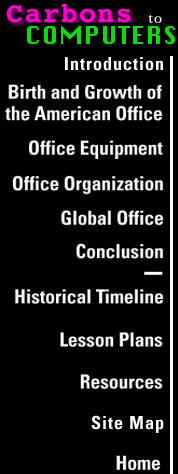
Dictating Machine
 The dictating machine is yet another example of the complex relationship
between technological development and what people need and want. Thomas
Edison's early phonograph, while a terrific idea, had dreadful sound, as
well as a limited number of prerecorded wax discs (records) to play, and
it wasn't selling well. The marketers of the phonograph thought to sell
it to offices as a dictating machine, but it failed there as well. Stenographers
hated it, and it was expensive. By the 1890s, it was already off the market.
The phonograph, with critical technical improvements in recording quality,
went on to achieve singular success.
The dictating machine is yet another example of the complex relationship
between technological development and what people need and want. Thomas
Edison's early phonograph, while a terrific idea, had dreadful sound, as
well as a limited number of prerecorded wax discs (records) to play, and
it wasn't selling well. The marketers of the phonograph thought to sell
it to offices as a dictating machine, but it failed there as well. Stenographers
hated it, and it was expensive. By the 1890s, it was already off the market.
The phonograph, with critical technical improvements in recording quality,
went on to achieve singular success.
Scientific management in its heyday, however, liked the dictating machine. It believed that not only would dictating letters into a machine cut the cost of producing a letter from 4.3 cents to 2.7 cents, but that the dictating machine could make the executive more creative. "Men who formerly dictated stilted letters have been taught by the dictating machine to express themselves lucidly," suggested one source. What scientific management was really trying to avoid was wasted time when the "dictator and stenographer engage in conversation entirely unconnected with the business at hand."

Some offices did use dictaphones, but most didn't. They were still cumbersome, intimidating, and poor recording machines. It took magnetic tape in the 1950s to make dictating practical. Dictating letters and memos and bright ideas into tape recorders, in cars as well as in executive suites, became standard office operating procedure that continues today, valued more by managers than by stenographers.